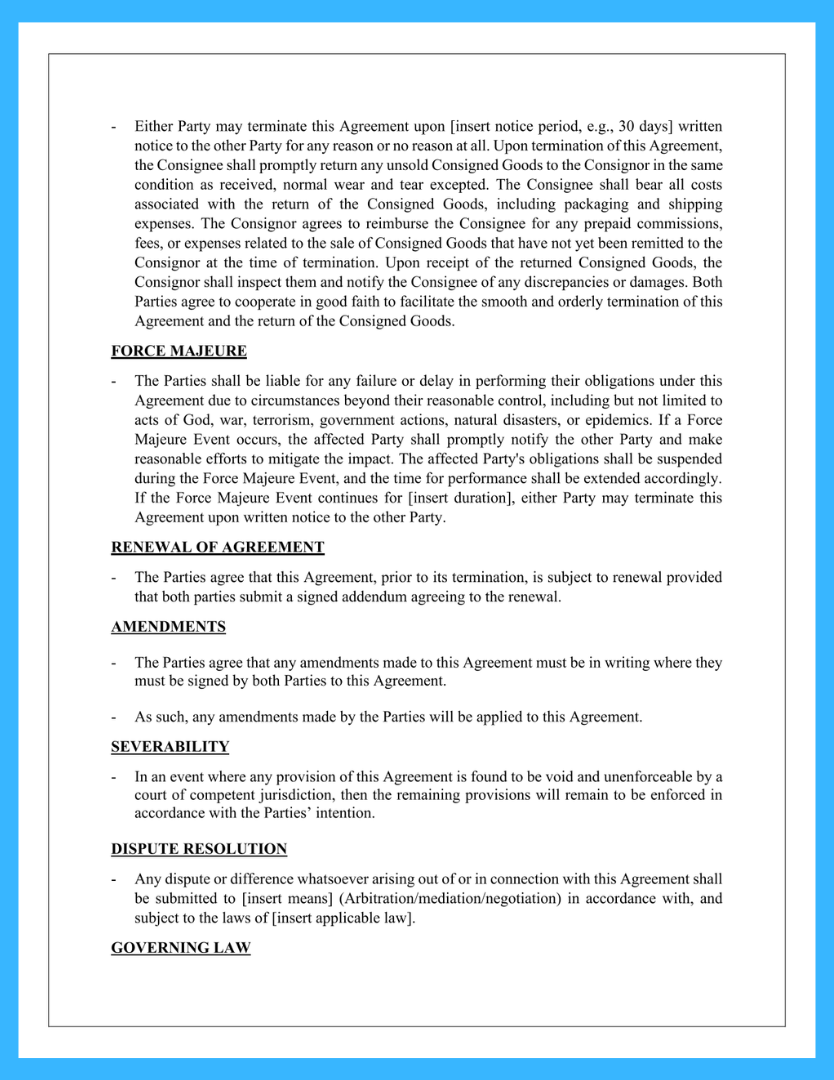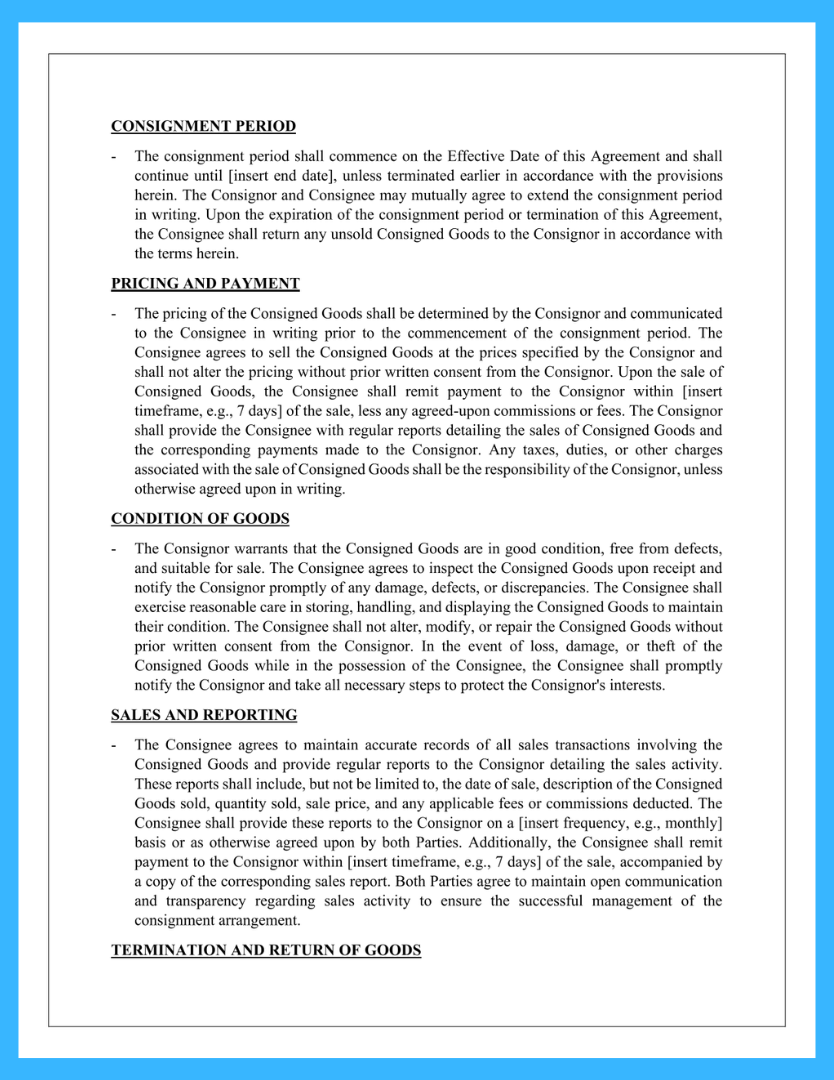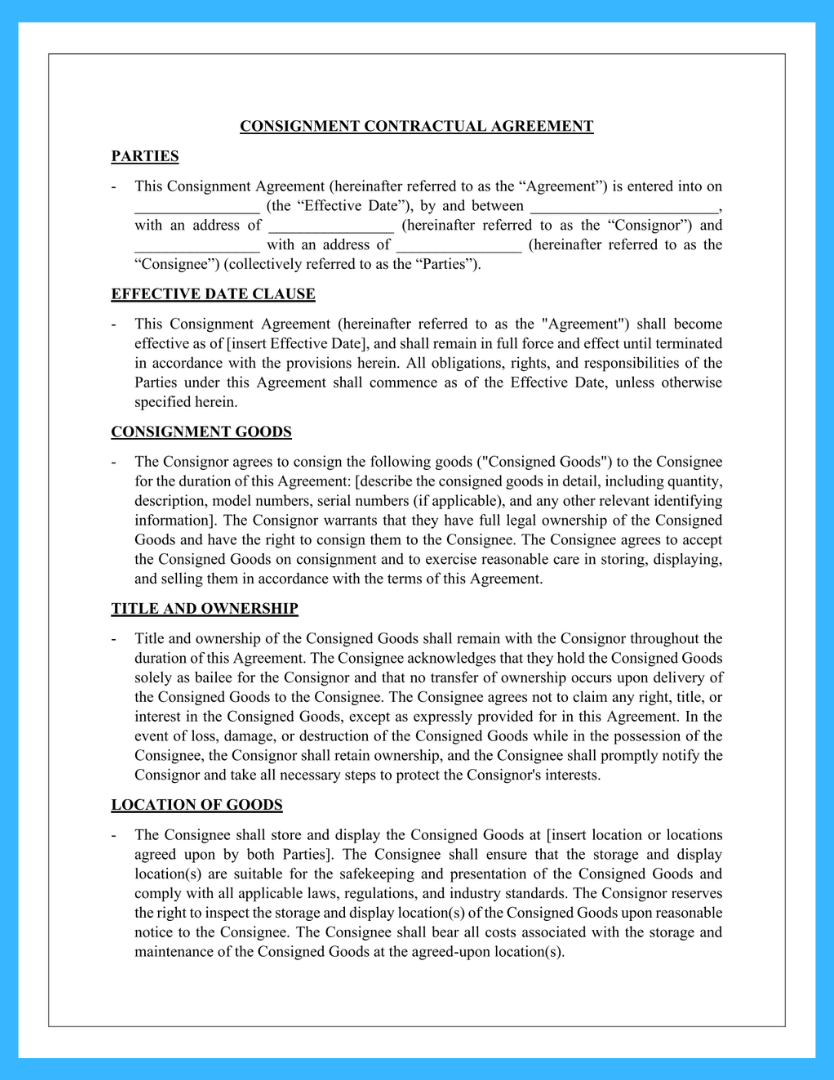
A consignment agreement clearly defines the terms between a consignor and consignee regarding the sale of goods. It’s an essential document for both parties, and having a robust consignment agreement template is critical to moving through your operations efficiently.



A consignment agreement is a legally binding contract between a consignor, or owner of the merchandise, and a consignee who sells the merchandise on behalf of the consignor. It allows the consignor to ship items for the consignee to trade in their retail location without purchasing the inventory upfront.
The agreement outlines crucial details, including:
In short, this critical legal document protects both the owner of the merchandise and the retailer selling it by clearly spelling out each party’s rights and responsibilities. For example, it gives the consignor confidence they will receive agreed-upon payment when items sell.
A consignment agreement template is crucial when a consignor plans to ship merchandise to a retailer for sale without the store purchasing the inventory.
For example, a fashion designer ready to get their clothes into boutiques would require consignment agreements before sending their newest line. An artist who crafts décor items to display in home goods stores also needs these contracts.
If a creator sends products to shops without selling the items to the stores outright, clear consignment terms must be set. This legally binding document protects both parties by spelling out revenue splits, timelines, return policies, and more critical details.
Specific examples that call for an official consignment contract include:
No matter what merchandise is involved or what type of retailer ultimately lists the items for sale, consignment agreements become essential. They provide creators confidence in the process while giving shops legal protection, too.
At the end of this article, you’ll find a free consignment agreement template to simplify the process so you can easily customize terms.
A typical consignment agreement splits the revenue from sales between the consignor, or owner of the merchandise, and the consignee, the retailer selling the products. The specifics vary, but a typical arrangement is a 60/40 split in favor of the consignor.
For example, designer Paula partners with a boutique called Fashion House to sell her new clothing line on consignment. The entire agreement outlines that Paula will receive 60% of the total sales, and Fashion House will take 40%.
When one of Paula’s $100 dresses sells, Fashion House pays Paula $60 as her cut. So, for every item sold, Paula multiplies the selling price by 60% to calculate her consignment payment.
This revenue split compensates the designer for creating the items while incentivizing the boutique to promote sales volume to maximize its 40% commission per sale. Tracking inventory and corresponding payments is essential.
The example terms can be customized in a consignment agreement template. Key details like revenue split percentages and payment timelines should be outlined upfront before selling goods on consignment in retail stores.
A consignment agreement template covers crucial details about the arrangement, including:
Clearly identifying the consignor or owner of the merchandise and the consignee or retailer helps ensure legal obligations are fully understood. Details like full business names, addresses, and points of contact should be included upfront. Having this specified background procedural information aids dispute resolution.
An itemized list describing the merchandise headed to the consignee’s store for sale is vital. All products sent on consignment should be cataloged by quantity, item numbers, sizes/dimensions, colors, and other identifiers. Photos can supplement the detailed descriptions. Complete transparency on inventory being consigned allows proper tracking and payment reconciliation when goods sell.
The template should grant the retailer or consignee authorization to sell the listed consignment goods in their store during the specified consignment period. Explicitly stating this “right to sell” consent helps avoid disputes. Outlining intended sales channels also provides helpful directionality.
To protect the consignor’s sales revenue, a minimum retail price for merchandise may be set, preventing goods from being discounted too heavily. Specifying floor prices for specific products or categories gives the consignor more control. Price limits motivate the most lucrative sales approach.
The consignment fee percentage owed to each party and corresponding payment terms must be established upfront. The date the consignee must pay the consignor after a sale could be monthly, quarterly, etc. Defining these compensation specifics eliminates payment delay tactics down the road.
Detailing the consignee’s business name and address where consigned merchandise will be located reassures the owner. It also specifies where unsold items must be returned at the end. Pinpointing display and storage expectations provides procedural direction.
The consignment period, with clear start and end dates, must be defined upfront. This gives both parties expectations for the merchandise turnover timeframe and return of any unsold items. Standard periods range from 30-90 days. Reasonable notice policies and durations motivate active promotion and sales.
To protect against loss due to damage, theft, etc., the agreement states who is responsible for maintaining insurance coverage on consigned goods. Often, the consignor/owner takes this on. However, deciding on insurance accountability shields against assumption gaps, leaving products at risk if incidents were to occur.
The template should outline how any changes can be made to the existing agreement terms. Reasons for early contract termination from one or both parties also need to be addressed. This prevents misunderstandings later. For example, language can specify that termination requests must be made in writing within XX days of signing by either the consignor or retailer. Modification procedures should also be formally submitted.
This covers any additional legal clauses not already outlined regarding disputes, confidentiality, severability, releases, waivers, disclaimers, etc. Defaulting to applicable laws in the absence of specified terms is also typically included. Critical areas like mediation guidance, confidentiality standards, and liability limitations should be pre-defined to streamline resolution processes if issues emerge.
Signed consent demonstrating the consignor/owner and consignee/retailer agree to all outlined terms and conditions is critical. Electronic signatures via Signaturely provide efficient, legal e-signature workflows.
Explicitly detailing obligations and securing sign-off from both parties in this comprehensive document protects consignment arrangements, preventing misunderstandings before selling goods.
We’ve got your back here at Signaturely, and we’re ready to help make stress-free contracts a reality. Forget the confusing paperwork and overwhelming legal jargon – get easy, breezy contract templates in minutes with our free template.
Click that download button now and get those wheels spinning!Having an explicit consignment agreement in place offers advantages, including:
Outlines obligations – Defines responsibilities of consignor and consignee regarding inventory, payment, timeline, insurance, etc.
In the event of a dispute, having this legally binding document ensures consensus on expectations and handles arbitration. It’s a failsafe for consignors and consignees alike.
Specific advantages that a precise consignment contract offers include:
Confusion gets avoided on sales commission revenue splits thanks to clearly articulated percentages within the agreements. Renegotiation proves more straightforward as well if terms require adjustment.
Bottom line: consignment contracts ultimately provide win-win relationships for retailers and product creators when done correctly. Merchandise gets displayed for sale, store revenue increases from new inventory, and designers/artists receive payment for goods that successfully move.
Creating a customized consignment agreement template to meet your specific needs can be challenging. Signaturely’s free online tool makes it fast and easy.
With Signaturely, both parties can collaboratively build out contract details like:
Once the agreement terms are defined, Signaturely facilitates the e-signature process to get a legally binding sign-off in minutes without any paperwork. Data encryption and secure document storage are even provided automatically.
See the consignment agreement template below to execute your consignment strategy. Build, e-sign, and manage yours with ease using Signaturely.